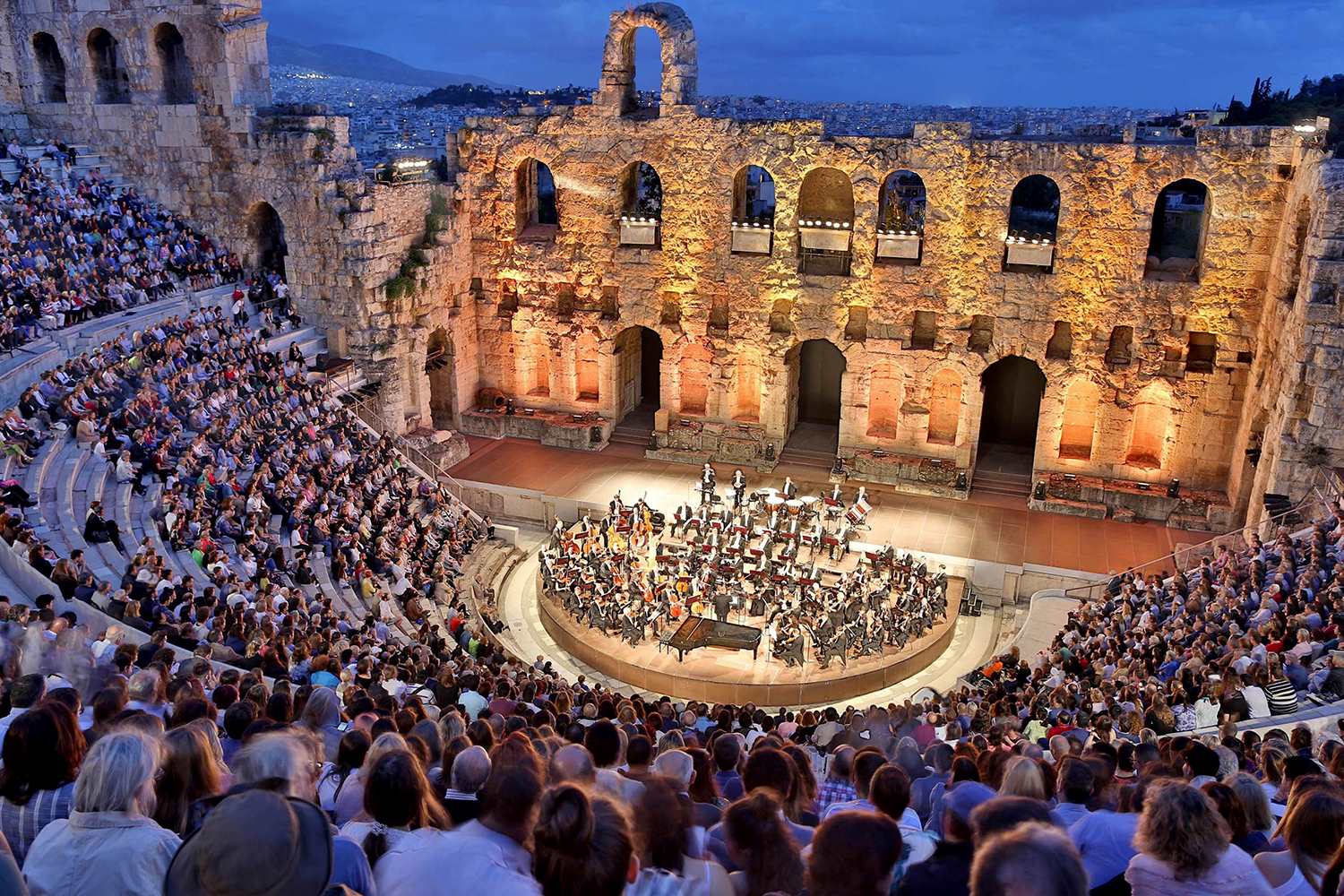
Did you know the Odeon of Herodes Atticus is one of the most stunning ancient theaters still in use today? Nestled on the southwest slope of the Acropolis in Athens, this architectural marvel has been captivating audiences since 161 AD. Built by Herodes Atticus in memory of his wife, Regilla, it originally featured a wooden roof made from cedar of Lebanon. Today, it hosts concerts, ballets, and classical performances, blending ancient history with modern culture. With a seating capacity of around 5,000, the Odeon offers breathtaking views of the Acropolis and the city of Athens. Ready to learn more? Here are 32 fascinating facts about this iconic venue!
The History of Odeon Of Herodes Atticus
The Odeon of Herodes Atticus is a magnificent stone theater located on the southwest slope of the Acropolis of Athens. It has a rich history that dates back to ancient Greece. Here are some fascinating facts about this historic site.
- Built in 161 AD, the Odeon was commissioned by Herodes Atticus, a wealthy Greek aristocrat, in memory of his wife, Aspasia Annia Regilla.
- The theater was originally covered with a wooden roof made of expensive cedar wood, which was quite rare for its time.
- It could seat approximately 5,000 spectators, making it one of the largest theaters in ancient Athens.
- The structure was primarily used for music concerts and theatrical performances, showcasing the cultural richness of ancient Greece.
- The Odeon was part of a larger complex that included the nearby Theater of Dionysus, emphasizing the importance of performing arts in Greek society.
Architectural Marvels
The design and construction of the Odeon of Herodes Atticus are nothing short of extraordinary. Let's delve into some of its architectural marvels.
- The theater's facade is made of stone and features a series of arches that add to its grandeur.
- The seating area, known as the cavea, is semi-circular and carved into the natural slope of the Acropolis hill.
- The stage building, or skene, was adorned with elaborate decorations and statues, enhancing the visual appeal of performances.
- The orchestra, a circular space in front of the stage, was used by the chorus during performances.
- The theater's acoustics are exceptional, allowing even the faintest sounds to be heard clearly by all spectators.
Restoration and Modern Use
Despite its ancient origins, the Odeon of Herodes Atticus has been restored and continues to be a significant cultural venue. Here are some facts about its restoration and modern use.
- The theater was extensively restored in the 1950s to preserve its historical significance and architectural integrity.
- It is now one of the main venues for the annual Athens and Epidaurus Festival, which features a variety of performances, including theater, music, and dance.
- Renowned artists such as Maria Callas, Luciano Pavarotti, and Elton John have performed at the Odeon, adding to its modern legacy.
- The theater is also used for special events, including ceremonies and award shows, highlighting its versatility.
- The restoration efforts have ensured that the Odeon remains a symbol of cultural heritage and artistic excellence.
Cultural Significance
The Odeon of Herodes Atticus holds immense cultural significance, both in ancient times and today. Here are some facts that highlight its cultural importance.
- In ancient Greece, the theater was a hub for cultural and social gatherings, reflecting the community's love for the arts.
- It served as a venue for the Panathenaic Festival, a major religious and cultural event in ancient Athens.
- The Odeon has been featured in numerous films and documentaries, showcasing its historical and architectural beauty to a global audience.
- It is considered one of the best-preserved ancient theaters in the world, attracting tourists and scholars alike.
- The theater's continued use for performances and events underscores its enduring relevance in contemporary culture.
Interesting Tidbits
Beyond its historical and cultural significance, the Odeon of Herodes Atticus has some intriguing tidbits that add to its allure. Here are a few interesting facts.
- The theater's name, "Odeon," comes from the Greek word "odeion," meaning a building for musical performances.
- Herodes Atticus, the benefactor of the theater, was a prominent figure in Roman Greece, known for his philanthropy and contributions to public works.
- The Odeon is located near the Acropolis Museum, making it a popular stop for tourists exploring the ancient landmarks of Athens.
- The theater's impressive acoustics are attributed to its unique design and the materials used in its construction.
- Despite being nearly 2,000 years old, the Odeon continues to inspire awe and admiration among visitors.
Fun Facts
Let's wrap up with some fun facts about the Odeon of Herodes Atticus that you might not know.
- The theater has been used as a backdrop for various fashion shows, blending ancient history with modern style.
- It is one of the few ancient theaters that still hosts performances, offering a unique experience for both artists and audiences.
- The Odeon has been a UNESCO World Heritage site since 1987, recognizing its historical and cultural significance.
- It is often illuminated at night, creating a stunning visual spectacle against the backdrop of the Acropolis.
- The theater's location offers breathtaking views of Athens, making it a favorite spot for photographers and sightseers.
- The Odeon has inspired numerous replicas and adaptations in other parts of the world, showcasing its enduring influence on theater architecture.
- Despite its ancient origins, the Odeon of Herodes Atticus remains a vibrant and dynamic venue, bridging the past and present in a truly unique way.
The Timeless Appeal of Odeon Of Herodes Atticus
The Odeon of Herodes Atticus stands as a testament to ancient Greek culture and architecture. Built in 161 AD, this amphitheater has witnessed countless performances, from classical plays to modern concerts. Its acoustic excellence and architectural beauty continue to draw visitors from around the globe. Nestled on the slopes of the Acropolis, it offers a unique blend of history and art. Whether you're a history buff or a music lover, the Odeon provides an unforgettable experience. Its enduring charm lies in its ability to connect the past with the present, making every visit a journey through time. So next time you're in Athens, don't miss the chance to explore this iconic venue. The Odeon of Herodes Atticus isn't just a relic; it's a living, breathing piece of history.
Was this page helpful?
Our commitment to delivering trustworthy and engaging content is at the heart of what we do. Each fact on our site is contributed by real users like you, bringing a wealth of diverse insights and information. To ensure the highest standards of accuracy and reliability, our dedicated editors meticulously review each submission. This process guarantees that the facts we share are not only fascinating but also credible. Trust in our commitment to quality and authenticity as you explore and learn with us.


